Upgrading Wheels and Tires on a GSL-SE
This document last modified January 5, 2004.
The stock tires on the GSL-SE were 205/60R14 Pirelli P6. This was a rather
high-performance tire in its day, but unfortunately, similar performing tires
in the GSL-SE's original size are becoming increasingly difficult to find.
It seems that most manufacturers are limiting their high-performance tire
offerings to larger wheel sizes that are commonplace on more contemporary
sports cars. This presents a dilemma for most GSL-SE owners: try to find
a suitable tire in a slightly different size, or settle for a lower performance, all
season tire in the original size? I decided to choose "option C" and upgrade
my wheels to a larger size in order to have access to the current market
of high performance tires.
"Plus sizing" wheels and tires is a fairly popular upgrade for any vehicle.
I decided to move up to a 15 inch wheel, and I knew exactly what style of
wheel that I wanted. I had seen the Panasport
brand in use on various Spec-RX7 race cars over the past few years, and I
was aware that Panasport also sold heavier-duty
street wheels in that same "minilite" style that
is so popular on many classic sports cars. But I wasn't absolutely sure about
all of the dimensions that must be specified when ordering replacement wheels,
so I called Panasport retailer K-Speed (http://www.kspeed.com) in Pennsylvania
for advice. Chuck at K-Speed knew exactly what works on my GSL- SE, so he
set me up with 15 x 7 wheels with a 33mm offset. (The stock wheels have a
40mm offset, so this will move the center line of the tire outboard by about
1/4".) With lug nuts and shipping, they came to $856.
The next concern would be what size tire to use with these wheels. I decided
to stick with a 205mm wide tire, but I was inclined to only drop down to
an aspect ratio of 55, rather than the more common 50 series that many folks
tend to choose for the GSL-SE. Two issues had me leaning towards the taller
tire:
1) The GSL-SE speedometer is known to be somewhat optimistic, and this
would correct that slightly.
2) Many of the roads that I commute on really suck. A little extra sidewall
flex would not be unappreciated.
Online retailer Tire Rack has a
tremendous amount of information about tire sizes on their web site. Browsing
Tire Rack's selections in the stock size, it seems that the average dimensions
for a 205/60R14 tire are:
Tire Diameter: 23.6 to 23.7 inches
Revolutions per mile: about 880
That compares to 205/50R15 tires, typically at
Tire Diameter: 23.0 to 23.1 inches
Revolutions per mile: about 900
and 205/55R15 tires, typically at
Tire Diameter: 23.9 inches
Revolutions per mile: about 870
You can see that the 55 series tire more closely matches the diameter
of the original tires. So that's what I ordered -- four Bridgestone Potenza S-03 tires in the 205/55R15 size, for the
low, low price of only $437.24, including shipping.
Second Thoughts...
As I soon found out, tire diameter is not the only important spec here!
Two width specifications that are usually shown on Tire Rack's web site for
any given tire are:
tread width -- which is usually close to the first number
given in the tire size, in this case, 205mm or 8.07 inches, and
section width -- which is the width of the tire
at its widest point on the sidewall.
For the purpose of predicting clearance
with fenders and suspension components, the section width specification is vitally important.
I would strongly suggest reading Tire Rack's explanation of Section
Width. In fact, read that whole page, and
you'll have a much better understanding of tire and wheel fitment.
Tire Rack listed a number of 205/60R14 tires as having section and tread
widths of 8.2 and 6.6 inches, on average, when mounted on a 6.5 inch wide
wheel. But the GSL-SE's stock wheels were only 5.5 inches wide -- read that Tire
Rack page regarding rim width! -- and I have since measured my last set of
205/60R14 tires as having a sectional width of about 7.95 inches while mounted
on the original wheels. Unfortunately, the new wheel and tire combination is somewhat wider than
the original set. Tire Rack lists these 55-series tires at 8.4 inches wide
when mounted on 6.5 inch wide wheels. I've since measured my 205/55R15 tires,
when mounted on 7 inch rims, at 8.68 inches wide.
Combined with the slight change in offset that I mentioned earlier, it
would seem that these tires are going to be about 1/2" closer to my suspension
components. Obviously, this should give rise to concerns about clearance
and rubbing with suspension components. Adding to my concerns, this car has
been lowered slightly with Eibach ProKit springs, which lower the front end by about 1 inch
and lower the rear by about 3/4 of an inch. My car also has a Ground Control
adjustable sway bar up front. The GC bar occasionally gets "polished" by
my autocross tires -- 225/45R13 Hoosiers on 8" wide wheels with 4.5" backspacing.
Do they fit?
Well... kinda yes, sorta
mostly... not really, but I made them fit anyway. Curiously enough,
there is no rubbing in the back of the tire, apparently because K-Speed's recommended
33 mm offset has the centerline of the wheel 7 mm further outboard
than the original wheel's 40 mm offset did. Still, the inside sidewall is
sooooooo close to the spring perch on the OEM style
strut that I can barely fit a folded piece of sandpaper between the tire
and the strut. But it does clear the strut.
The outside sidewall DOES have a clearance problem, though, with the front
fender lip. After a few hot laps around an Army base parking lot -- there were
no MPs in sight! -- I could see that there were a few
little slivers of rubber that have been surgically removed from the sidewall.
We're talking fractions of a millimeter here, no real harm done.
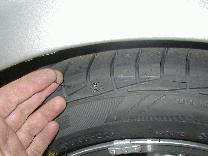
(Click to see a larger image.)
At first, this seemed odd to me, because I purposely chose to
stick with the original 205 mm tread width in an effort to avoid this problem.
What I didn't factor in, though, was the additional section width -- the
width of the tire at its widest point -- as a result of mounting this particular tire on a 1.5
inch wider wheel. As it turns out, this tire and wheel combination is 8.7
inches wide, versus just a hair under 8 inches wide for the original wheel
and tire sizes.
During the damage assessment, I was able to see that there was really only one
section of the fender lip that would rub against the tire during hard cornering:
approximately the first 6 to 8 inches rearward from the top of the wheel well.
A few friends recommended rolling a baseball bat along the tire, between the corner
of the tread and the fender lip. Not having a baseball bat handy, I managed
to find a pipe that was about 1.5 to 2 inches in diameter. This allowed me
to bend the lip up from the original 90 degree angle to about 45 degrees, gaining
another 2 to 3mm of clearance on the inside of the fender, with no external signs
that the fender has been modified at all. I suspect that I could have also reached
that amount of clearance by slotting the strut tower tops slightly, in order to
get a bit more camber on the front tires -- pulling the top of the tire inward.
This is something that I've wanted to do for autocross purposes, anyway, so I may
yet get to this someday. We'll see.
After another "enthusiastic" test drive, I can confidently declare that there's
no more rubbing. I even made a point of deliberately looking for railroad
crossings and speed bumps -- think "Dukes of Hazard" here -- and nothing,
nope, nada. No more rubbing. :)
The results are in:
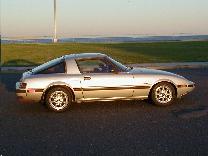
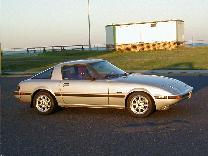
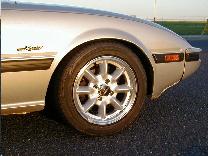
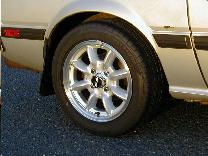
Obviously, I'm very pleased with the appearance. The fit is a little tight,
though. Too tight actually.
Of note, however, is that these tires feel considerably more responsive
than my four year old Bridgestone RE-71s, while at the
same time feeling lighter and easier to turn
in parking maneuvers. The parking ease probably has to do with the near-slick
condition of my old tires, and the responsiveness is likely a combination
of the wider wheel providing more sidewall support and the old tires' thoroughly
exhausted sidewalls. Overall, the feel at the steering wheel is downright
awesome.
If you're looking for a recommendation, I wouldn't hesitate to suggest a similar upgrade.
But I would also caution against the exact same combination of tires and wheels that I used.
I suspect that, for a lowered GSL-SE, that a 6.5 inch wide wheel might have been a better
choice. In Chuck's defense, I never mentioned to him that my car has been lowered.
Then again, he didn't ask. Also, neither of us knew then that I was going to be purchasing a 205/55R15 tire
with the widest section width available among tires of that size. Changing either of
those factors would have likely kept me out of trouble regarding fender clearance.
So, if you're leaning toward the same upgrade, go ahead. Just do it a little bit differently.
Unless you're handy with a baseball bat. :)




